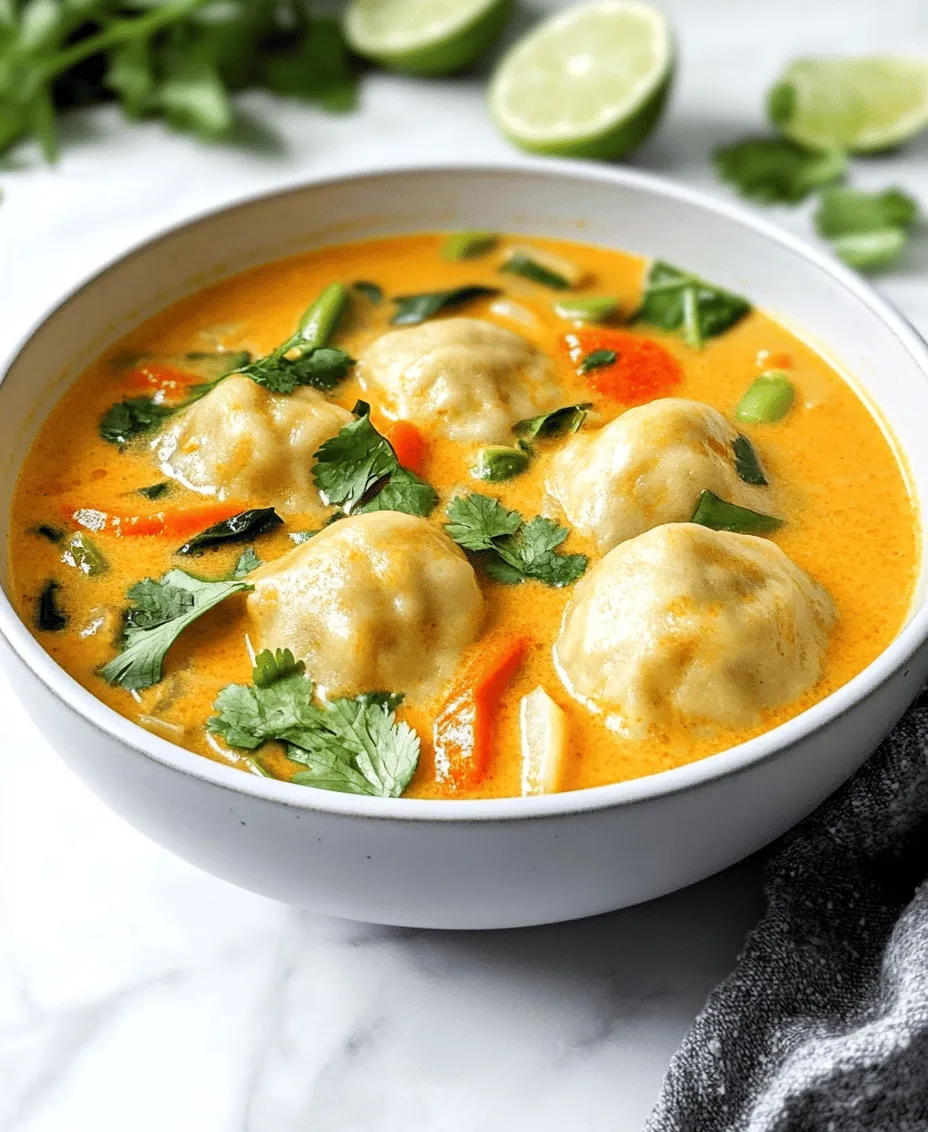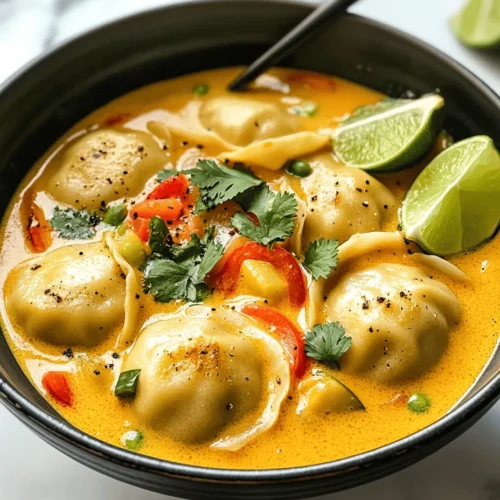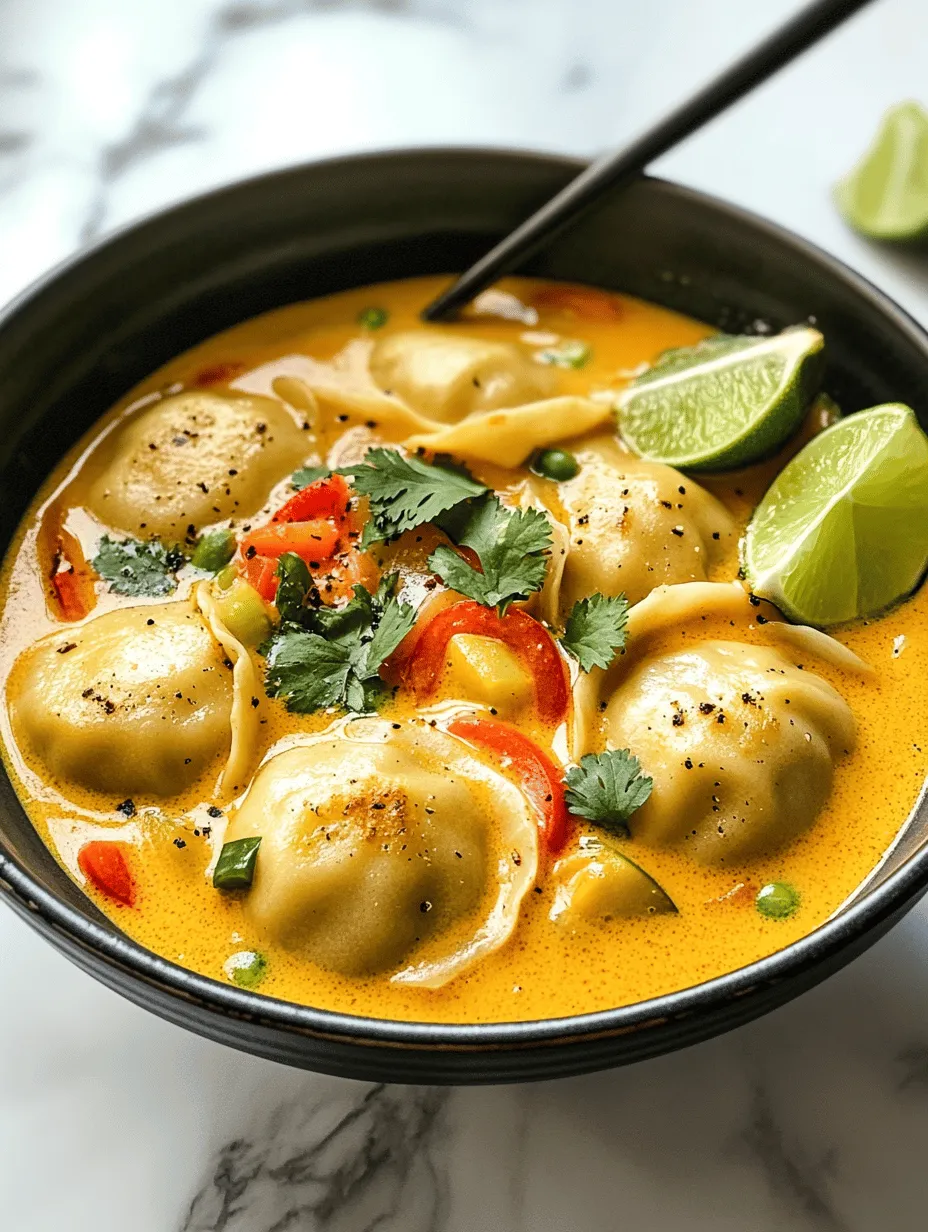Introduction
Curry dumpling soup is a delightful fusion dish that marries the comforting warmth of soup with the exciting flavors of curry and the satisfying chew of dumplings. This recipe showcases a rich, aromatic broth infused with spices, accompanied by tender dumplings that can be filled with your choice of chicken or tofu, making it an adaptable dish for various dietary preferences. In a world where comfort food often means a cozy bowl of soup, curry dumpling soup stands out as a hearty option, perfect for family dinners or a gathering of friends.
Comfort food holds a special place in home cooking; it evokes a sense of warmth and nostalgia, often reminding us of cherished moments spent around the dinner table. This curry dumpling soup not only embraces those elements but also invites you to experiment with flavors and textures in the kitchen. Whether you are seeking a savory meal to warm you on a cold evening or a crowd-pleasing dish for a potluck, this soup caters to all cravings and occasions.
The beauty of this recipe lies in its versatility. You can tailor the dumpling filling to suit your dietary needs—whether you prefer juicy ground chicken or a plant-based tofu mixture, both options deliver a satisfying bite. With a few adjustments, you can also cater to gluten-free diets by opting for alternative flours. This recipe is about more than just nourishment; it’s an opportunity to express your culinary creativity while enjoying a delicious and wholesome meal.
Understanding Curry Dumpling Soup
Curry dumpling soup has its roots in various Asian cuisines, drawing influences from Chinese, Thai, and Indian traditions. The combination of fragrant curry spices with the comforting texture of dumplings creates a dish that is both familiar and exotic. In many cultures, dumplings serve as a staple food, representing togetherness and shared meals. They are versatile in their fillings and shapes, but when paired with a spicy curry broth, they transform into an unforgettable culinary experience.
The flavor profile of curry dumpling soup is a delightful interplay of spices, textures, and aromas. Expect the warm notes of turmeric, cumin, and coriander to dance on your palate, complemented by the creaminess of coconut milk or the umami depth of chicken broth. The dumplings themselves add a chewy, satisfying texture, making each spoonful a delightful balance of flavors. This soup is not just a meal; it’s an exploration of taste that invites you to savor every bite.
Opting for homemade soup over store-bought varieties is a decision that pays off in taste and health. Homemade soup allows you to control the ingredients, ensuring that each component aligns with your culinary vision. You can adjust the spice levels, choose high-quality proteins, and add fresh vegetables for a nutritious boost. Plus, the act of making soup from scratch is a rewarding journey that fills your kitchen with enticing aromas and creates a sense of accomplishment.
Ingredients Breakdown
Creating the best curry dumpling soup starts with a well-thought-out list of ingredients. Below, we break down the essential components you will need for the dumplings, filling, and soup, along with tips for substitutions to accommodate various dietary restrictions.
For the Dumplings:
– All-Purpose Flour: Serves as the base for the dumpling dough. It provides the necessary structure and chewiness. For a gluten-free option, consider using a gluten-free flour blend.
– Salt: Enhances the flavor of the dough, ensuring that the dumplings are tasty even on their own.
– Water: Hydrates the flour to form a pliable dough. Adjust the amount as needed to achieve the right consistency.
For the Filling:
– Ground Chicken or Firm Tofu: The protein source for the filling. Ground chicken offers a juicy flavor, while tofu provides a plant-based alternative. If using tofu, ensure it is well-pressed to remove excess moisture.
– Green Onions: Adds a fresh, mild onion flavor that complements the filling.
– Garlic and Ginger: Essential aromatics that infuse the filling with depth and warmth.
– Soy Sauce: Contributes umami flavor and moisture to the filling. For a gluten-free version, use tamari.
– Sesame Oil: Adds a rich, nutty flavor that enhances the overall taste of the filling.
For the Soup:
– Coconut Milk: Provides creaminess and a subtle sweetness to balance the spices. You can substitute with vegetable broth for a lighter option.
– Vegetable or Chicken Broth: The base for the soup that adds depth and flavor. Homemade broth is best, but store-bought options work well too.
– Curry Powder: The star seasoning that infuses the soup with aromatic flavors. You can use store-bought curry powder or create your own blend.
– Vegetables (e.g., carrots, bell peppers, spinach): Adds color, texture, and nutrition. Use whatever vegetables you have on hand or prefer.
– Lime Juice: Brightens the soup with acidity, enhancing the overall flavor profile.
Each ingredient plays a pivotal role in creating the delicious flavor and texture of curry dumpling soup. While it’s essential to follow the recipe closely for the best results, don’t hesitate to get creative and make substitutions based on your dietary needs or preferences.
Creating the Dumplings
Now that you have your ingredients ready, it’s time to embark on the journey of making the dumplings. This section will guide you through the process, ensuring that you achieve the perfect dumpling dough and shape.
Step 1: Making the Dumpling Dough
1. Combine the Ingredients: In a large mixing bowl, combine the all-purpose flour and salt. Gradually add water, mixing with your hands or a wooden spoon until a rough dough begins to form.
2. Knead the Dough: Transfer the dough to a lightly floured surface. Knead the dough for about 5-7 minutes until it becomes smooth and elastic. This step is crucial—kneading develops the gluten, which gives the dumplings their structure.
3. Rest the Dough: Once kneaded, wrap the dough in plastic wrap or place it in a bowl covered with a damp cloth. Let it rest for at least 30 minutes. This resting period allows the gluten to relax, making it easier to roll out later.
Step 2: Forming the Dumplings
1. Roll Out the Dough: After resting, divide the dough into smaller portions for easier handling. Roll out each portion on a lightly floured surface to about 1/8-inch thickness. Aim for even thickness to ensure uniform cooking.
2. Cut the Dough: Use a round cutter (about 3 inches in diameter) to cut out circles from the rolled dough. Gather and re-roll any scraps to create more dumpling wrappers.
3. Fill the Dumplings: Place about a teaspoon of the filling in the center of each dough circle. Be careful not to overfill, as this can lead to bursting during cooking.
4. Seal the Dumplings: Moisten the edges of the dough with water, then fold the dough over the filling to create a half-moon shape. Pinch the edges firmly to seal, ensuring that no filling escapes. For a decorative touch, you can pleat the edges or shape them however you prefer.
5. Variations in Dumpling Shapes: Feel free to experiment with the shapes of your dumplings! Traditional shapes include half-moons or pleated dumplings, but you can also try creating round or even triangular dumplings based on your preference.
With your dumplings prepared, you are ready for the next exciting phase of this recipe—creating the flavorful filling and then bringing your curry dumpling soup to life! In the following sections, we will delve into the process of preparing the filling and crafting the aromatic soup that will bring your dumplings to the next level.

Suggestions for Additional Ingredients to Customize Filling
When it comes to crafting the perfect filling for your dumplings, creativity is key. While the basic ingredients offer a robust flavor, consider enhancing it with additional herbs and spices that reflect your personal taste. Here are some options:
1. Herbs: Fresh herbs can elevate the flavor of your dumplings significantly. Try adding finely chopped cilantro, basil, or mint to your filling for a fresh kick. These herbs not only enhance the flavor but also add vibrant color.
2. Spices: Consider incorporating spices such as ground coriander, cumin, or chili flakes. These spices will contribute additional warmth and complexity to your dumpling filling. If you enjoy a touch of heat, a pinch of cayenne pepper or some finely chopped jalapeño could also be a great addition.
3. Aromatics: Don’t shy away from adding finely minced garlic or shallots to your filling. These aromatics can deepen the flavor and give your dumplings an aromatic punch.
4. Vegetable Add-ins: Grated carrots, finely chopped bell peppers, or chopped green onions can add texture and flavor to your dumplings. They also contribute to the nutritional value of the dish.
By customizing your dumpling filling, you can create a unique flavor profile that suits your palate, making each batch a delightful experience.
Crafting the Soup Base
The soup base is the heart of your curry dumpling soup, and crafting it with care will make all the difference in flavor. Follow these steps for a deliciously rich and aromatic base.
Step-by-Step Process for Making the Soup
1. Heat the Pot: Start by heating a large pot over medium heat. Add a tablespoon of oil (coconut oil is a great choice for flavor) and allow it to warm.
2. Sauté Aromatics: Add diced onions and minced garlic to the pot. Sauté until they become translucent and fragrant, about 3-4 minutes.
3. Incorporate Red Curry Paste: This is where the magic begins. Add your red curry paste to the pot and sauté for an additional 2-3 minutes. This step is crucial as it releases the essential oils in the spices and enhances the overall depth of flavor.
4. Pour in the Coconut Milk: Once the curry paste is fragrant, pour in a can of coconut milk. Stir well to combine, allowing the creamy texture to meld with the spices. The coconut milk not only adds richness but also balances the heat of the curry.
5. Add Broth: At this point, you can choose between using homemade broth or store-bought. If you have homemade broth on hand, it will add an unparalleled depth of flavor. If not, a high-quality store-bought vegetable or chicken broth works perfectly. Add about four cups of broth to the pot and stir to combine.
6. Simmer: Bring the soup base to a gentle simmer. You want to allow the flavors to meld together beautifully. Let it simmer for about 10-15 minutes, stirring occasionally.
Cooking the Dumplings in the Soup
Now that your soup base is ready, it’s time to cook the dumplings and bring the dish together.
Instructions for Adding Dumplings to the Simmering Soup
1. Prepare Dumplings: If you haven’t already, prepare your dumplings according to your chosen filling recipe and ensure they are well-sealed.
2. Add Dumplings to Soup: Gently drop the dumplings into the simmering soup, being careful not to overcrowd the pot. You want to give them space to cook evenly.
3. Monitor Cooking Time: Allow the dumplings to cook for about 6-8 minutes, or until they float to the top. Floating is a good indicator that they are done. Keep an eye on them to prevent overcooking, which can lead to a gummy texture.
4. Avoiding Stickiness: To prevent dumplings from sticking together, stir gently with a wooden spoon. Avoid vigorous stirring, as this could break the dumplings apart.
Incorporating Vegetables
Adding vegetables to your curry dumpling soup not only enhances the flavor but also increases its nutritional value.
How to Select and Prepare Mixed Vegetables
Choose colorful vegetables that can complement the soup. Common choices include:
– Bell Peppers: Their sweetness adds a lovely contrast to the curry.
– Snap Peas: These provide a satisfying crunch and bright color.
– Carrots: Their sweetness balances the spice and adds texture.
Nutritional Benefits of Adding Vegetables
Incorporating vegetables into your soup boosts its fiber content, vitamins, and minerals. Vegetables like carrots provide beta-carotene, while bell peppers are rich in vitamin C, helping to enhance your immune system.
Timing for Adding Vegetables
Add your prepared vegetables to the soup about 4-5 minutes before serving. This timing will ensure they retain their crunch and vibrant color while still becoming tender and flavorful.
Serving Suggestions
Presentation is key when serving your curry dumpling soup. Here are some tips to make it visually appealing:
1. Garnish Generously: Top each bowl with a generous sprinkle of fresh cilantro and a squeeze of lime. The brightness from the lime enhances the flavors and adds a fresh touch.
2. Use Attractive Bowls: Serve the soup in vibrant bowls that contrast the colors of the soup. Deep bowls allow for a beautiful presentation and make it easier to enjoy the soup.
3. Suggested Pairings: Consider serving your curry dumpling soup with a side of crusty bread or steamed jasmine rice. Both options are perfect for soaking up the delicious broth and complement the dish beautifully.
Nutritional Benefits of Curry Dumpling Soup
This dish is not just delicious; it’s also packed with health benefits due to its wholesome ingredients.
Overview of Key Ingredients
– Coconut Milk: While creamy and rich, coconut milk is also a great source of healthy fats, which can help with nutrient absorption.
– Ginger: This powerful root adds a zesty flavor and has anti-inflammatory properties.
– Vegetables: As mentioned earlier, the variety of vegetables provides essential vitamins, minerals, and fiber, making your soup a well-rounded meal.
Balanced Nutrition
Your curry dumpling soup offers a balanced mix of protein from the dumplings, carbohydrates from any sides you choose to serve, and healthy fats from the coconut milk. This balance helps keep you satisfied and nourished.
Conclusion
Cooking and enjoying homemade curry dumpling soup is not just about the meal; it’s about the experience. The process of crafting a flavor-packed soup from scratch is rewarding, and experimenting with ingredients allows you to make the recipe uniquely yours.
As you become more comfortable with the steps outlined, feel free to explore variations of the recipe. Add seasonal vegetables, adjust the spice level, or even experiment with different types of dumplings. The beauty of this soup lies in its versatility and the joy it brings when shared with loved ones.
So gather your ingredients, get cooking, and savor the comfort that a warm bowl of curry dumpling soup brings to your table. Enjoy the journey of flavors and the satisfaction of creating a dish that is not only nourishing but also a delight to share.



